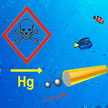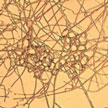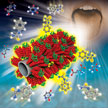Showing Spotlights 1385 - 1392 of 2783 in category All (newest first):
 As nanotechnologies are beginning to empower our lives in so many ways, understanding the environmental health and safety aspect of nanotechnology has become a crucial issue. The lack of information on the impact of engineered nanomaterials on organisms and the environment motivates researchers all over the world to strive for a better understanding of the implications of nanotechnology applications. Researchers have now provided a mechanistic understanding on how nanomaterials affect zebrafish embryos development and specifically answers the question on what causes the embryos to fail hatching at due time.
As nanotechnologies are beginning to empower our lives in so many ways, understanding the environmental health and safety aspect of nanotechnology has become a crucial issue. The lack of information on the impact of engineered nanomaterials on organisms and the environment motivates researchers all over the world to strive for a better understanding of the implications of nanotechnology applications. Researchers have now provided a mechanistic understanding on how nanomaterials affect zebrafish embryos development and specifically answers the question on what causes the embryos to fail hatching at due time.
Dec 20th, 2012
 Researchers are applying various strategies to designing nanoscale propulsion systems by either using or copying biological systems such as the flagellar motors of bacteria or by employing various chemical reactions. Different practical micromotor applications, ranging from drug delivery, to target isolation and environmental remediation, have thus been reported over the past 2-3 years. Yet, there are no reports on a nanomachine-based toxicity assay approach, analogous to the use of live aquatic organisms for testing the quality of our water resources.
Researchers are applying various strategies to designing nanoscale propulsion systems by either using or copying biological systems such as the flagellar motors of bacteria or by employing various chemical reactions. Different practical micromotor applications, ranging from drug delivery, to target isolation and environmental remediation, have thus been reported over the past 2-3 years. Yet, there are no reports on a nanomachine-based toxicity assay approach, analogous to the use of live aquatic organisms for testing the quality of our water resources.
Dec 19th, 2012
 Naturally occurring nanomaterials can be found everywhere in nature - in soil, ground and surface waters, volcanic ash, ocean spray, mineral composites, smoke. Biogenic magnetite nanoparticles have even been discovered in various organisms, ranging from bacteria to human brains, with various biological functions. Researchers have discovered that nanoparticles produced by a flesh-eating fungus hold promise for stimulating the immune system and killing tumors.
Naturally occurring nanomaterials can be found everywhere in nature - in soil, ground and surface waters, volcanic ash, ocean spray, mineral composites, smoke. Biogenic magnetite nanoparticles have even been discovered in various organisms, ranging from bacteria to human brains, with various biological functions. Researchers have discovered that nanoparticles produced by a flesh-eating fungus hold promise for stimulating the immune system and killing tumors.
Dec 18th, 2012
 Nanotechnology can play a significant role in the construction industry and stands at eighth position in terms of most significant areas of applications in nanotechnology. Nanoengineering of cement-based materials can result in outstanding or smart properties. Introduction of nanotechnology in cement industry has the potential to address some of the challenges such as CO2 emissions, poor crack resistance, long curing time, low tensile strength, high water absorption, low ductility and many other mechanical performances.
Nanotechnology can play a significant role in the construction industry and stands at eighth position in terms of most significant areas of applications in nanotechnology. Nanoengineering of cement-based materials can result in outstanding or smart properties. Introduction of nanotechnology in cement industry has the potential to address some of the challenges such as CO2 emissions, poor crack resistance, long curing time, low tensile strength, high water absorption, low ductility and many other mechanical performances.
Dec 17th, 2012
 Conventional electronic tongues utilize pattern recognition for analysis using arrays of synthetic materials such as polymers, artificial membranes and semiconductors, for applications in the food and beverage industries. Even with current technological advances, e-tongue approaches still cannot mimic the biological features of the human tongue with regard to identifying elusive analytes in complex mixtures, such as food and beverage products. But researchers have now developed a human bitter-taste receptor as a nanobioelectronic tongue. They utilized a human taste receptor as a sensing element for mimicking the human taste system and selective detection.
Conventional electronic tongues utilize pattern recognition for analysis using arrays of synthetic materials such as polymers, artificial membranes and semiconductors, for applications in the food and beverage industries. Even with current technological advances, e-tongue approaches still cannot mimic the biological features of the human tongue with regard to identifying elusive analytes in complex mixtures, such as food and beverage products. But researchers have now developed a human bitter-taste receptor as a nanobioelectronic tongue. They utilized a human taste receptor as a sensing element for mimicking the human taste system and selective detection.
Dec 14th, 2012
 Nanotechnology-enabled bio-pharmaceuticals are the most innovative and highly specialized alternative medicines for curing chronic diseases. These functionally modified nanomaterials help in early detection of chronic diseases. In addition to this, they also detect the microorganisms and viruses associated with infections. In this article, the authors analyze the immense potential of nanotechnology in India's pharmaceutical and biotechnology industries.
Nanotechnology-enabled bio-pharmaceuticals are the most innovative and highly specialized alternative medicines for curing chronic diseases. These functionally modified nanomaterials help in early detection of chronic diseases. In addition to this, they also detect the microorganisms and viruses associated with infections. In this article, the authors analyze the immense potential of nanotechnology in India's pharmaceutical and biotechnology industries.
Dec 13th, 2012
 Fuel cells are able to convert chemical energy to electrical energy with little pollutant emission and high energy conversion efficiency. Despite these advantages, the performance of fuel cells depends largely on the oxygen reduction reaction (ORR), which is substantially affected by the activity of the cathode catalyst. Since the sluggish kinetics of ORR is the major factor impeding large-scale application of fuel cells, most research focuses on developing efficient catalysts for ORR.
Fuel cells are able to convert chemical energy to electrical energy with little pollutant emission and high energy conversion efficiency. Despite these advantages, the performance of fuel cells depends largely on the oxygen reduction reaction (ORR), which is substantially affected by the activity of the cathode catalyst. Since the sluggish kinetics of ORR is the major factor impeding large-scale application of fuel cells, most research focuses on developing efficient catalysts for ORR.
Dec 12th, 2012
 Energy-relevant materials like selenium have photovoltaic and photoconductive properties that make them interesting for the manufacture of solar cells and lighting devices. In most of these applications, as with all nanomaterials, the material surface plays a critical role. Therefore, their surface properties, and more particularly their solid surface energy - the energy required to create a new surface - have to be carefully determined in order to fully understand and control relevant manufacturing parameters for devices based on these materials.
Energy-relevant materials like selenium have photovoltaic and photoconductive properties that make them interesting for the manufacture of solar cells and lighting devices. In most of these applications, as with all nanomaterials, the material surface plays a critical role. Therefore, their surface properties, and more particularly their solid surface energy - the energy required to create a new surface - have to be carefully determined in order to fully understand and control relevant manufacturing parameters for devices based on these materials.
Dec 11th, 2012
 As nanotechnologies are beginning to empower our lives in so many ways, understanding the environmental health and safety aspect of nanotechnology has become a crucial issue. The lack of information on the impact of engineered nanomaterials on organisms and the environment motivates researchers all over the world to strive for a better understanding of the implications of nanotechnology applications. Researchers have now provided a mechanistic understanding on how nanomaterials affect zebrafish embryos development and specifically answers the question on what causes the embryos to fail hatching at due time.
As nanotechnologies are beginning to empower our lives in so many ways, understanding the environmental health and safety aspect of nanotechnology has become a crucial issue. The lack of information on the impact of engineered nanomaterials on organisms and the environment motivates researchers all over the world to strive for a better understanding of the implications of nanotechnology applications. Researchers have now provided a mechanistic understanding on how nanomaterials affect zebrafish embryos development and specifically answers the question on what causes the embryos to fail hatching at due time. 
 Subscribe to our Nanotechnology Spotlight feed
Subscribe to our Nanotechnology Spotlight feed





